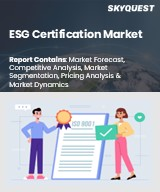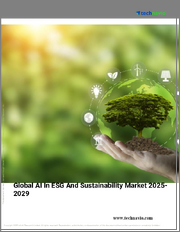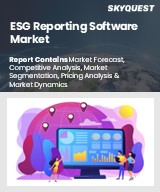
|
시장보고서
상품코드
1859437
ESG 인증 시장 규모, 점유율, 성장 분석 : 인증 유형별, 산업별, 최종사용자별, 서비스 유형별, 환경 영향별, 지역별 - 산업 예측(2025-2032년)ESG Certification Market Size, Share, and Growth Analysis, By Certification Type (ISO 14001, ISO 26000), By Industry, By End User, By Service Type, By Environmental Impact, By Region - Industry Forecast 2025-2032 |
||||||
세계의 ESG 인증 시장 규모는 2023년에 69억 달러로 평가되었으며, 2024년 78억 달러에서 2032년에는 207억 3,000만 달러로 성장하여 예측 기간(2025-2032년) 동안 CAGR 13.0%로 성장할 전망입니다.
기업의 책임, 지속가능성 보고, 기업의 사회적 책임에 대한 관심이 높아지고 규제 압력이 증가함에 따라 ESG 인증에 대한 수요가 증가하고 있습니다. 이러한 시장 성장은 투명성 프레임워크, 지속가능한 금융 표준, ESG 관행을 강화하는 디지털 컴플라이언스 툴의 전 세계적인 확산에 힘입어 성장세를 보이고 있습니다. ESG 인증은 다양한 지속가능성 기준을 통합한 광범위한 영역을 포괄하고 있으며, 조직 전략과 리스크 관리에 필수적인 요소로 자리 잡고 있습니다. 기업들이 측정 가능한 ESG 성과를 보여주기 위해 노력함에 따라 금융 서비스, 제조업, 소매업, 에너지 등 다양한 분야에서 인증에 대한 수요가 증가할 것으로 예상됩니다. 이러한 종합적인 접근을 통해 ESG 인증은 세계 지속가능성 목표에 부합하고 시장 경쟁력을 향상시키고자 하는 기업에게 필수적인 요소로 자리매김하고 있습니다.
세계 ESG 인증 시장의 촉진요인
투자자들 사이에서 지속가능하고 책임감 있는 비즈니스 관행을 중시하는 경향이 강화되면서 세계 ESG 인증 시장이 크게 성장하고 있습니다. 투자자들은 윤리적이며 지속가능한 사업에서 확고한 실적을 보이는 기업을 선호하는 경향이 있습니다. 이러한 접근 방식은 리스크를 줄이고 장기적인 수익을 보장하는 데 도움이 되기 때문입니다. ESG 인증은 투자자의 신뢰를 높이고, 보다 광범위한 세계 자본에 어필할 수 있는 표준화된 평가 척도로 작용합니다. 투명성과 책임성을 촉진함으로써 인증은 기업에 대한 신뢰를 공고히 할 뿐만 아니라 지속가능한 개발과 책임 있는 거버넌스를 위해 노력하는 조직에 대한 투자 흐름을 촉진합니다.
세계 ESG 인증 시장 억제요인
세계 ESG 인증 시장은 특히 중소기업(SME)의 경우, 인증 획득 및 유지와 관련된 높은 비용으로 인한 어려움에 직면해 있습니다. 감사, 컨설팅 서비스, 보고 프레임워크, 기술 통합과 관련된 비용은 상당한 장애물이 되고 있습니다. 이러한 경제적 부담은 경영 자원이 한정된 많은 기업들이 ESG 인증을 추구하는 것을 주저하게 만들고, 결국 이러한 지속가능성 실천을 광범위하게 채택하는 것을 방해하는 요인이 됩니다. 그 결과, 시장 진입 기업이 ESG 표준 준수를 달성하고 유지하는 데 필요한 조치를 시행하는 데 어려움을 겪게 되고, 시장 성장과 진입이 제한될 수 있습니다.
세계 ESG 인증 시장 동향
세계 ESG 인증 시장은 디지털 도구의 광범위한 채택을 특징으로 하는 변혁적 추세를 목격하고 있습니다. 인공지능, 블록체인, 클라우드 컴퓨팅과 같은 기술은 인증 환경에 혁명을 일으켜 프로세스를 더 빠르고, 더 안정적이며, 더 확장 가능하게 만들고 있습니다. AI는 광범위한 ESG 데이터 분석을 용이하게 하고, 조직이 위험을 식별하고 확립된 국제 표준을 준수하는지 검증할 수 있도록 지원합니다. 동시에 블록체인 기술은 신뢰성과 투명성을 높이고 부정확한 주장과 그린워시의 위험을 최소화합니다. 또한, 클라우드 솔루션은 경제적 장벽을 낮춰 중소기업의 인증 접근을 민주화하고, 모든 사업 규모의 참여를 촉진함으로써 전체 시장의 성장을 촉진하고 있습니다.
목차
소개
- 조사 목적
- 조사 범위
- 정의
조사 방법
- 정보 조달
- 2차와 1차 데이터 방법
- 시장 규모 예측
- 시장 가정과 제한
주요 요약
- 세계 시장 전망
- 공급과 수요 동향 분석
- 부문별 기회 분석
시장 역학과 전망
- 시장 개요
- 시장 규모
- 시장 역학
- 성장 촉진요인과 기회
- 성장 억제요인과 과제
- Porters 분석
주요 시장 인사이트
- 핵심성공요인
- 경쟁 정도
- 주요 투자 기회
- 시장 생태계
- 시장 매력 지수(2024년)
- PESTEL 분석
- 거시경제 지표
- 밸류체인 분석
- 가격 분석
ESG 인증 시장 규모 : 인증 유형별 & CAGR(2025-2032년)
- 시장 개요
- ISO 14001
- ISO 26000
- SA8000
- GGOTS(글로벌 유기농 섬유 표준)
- 공정무역 인증
- LEED(에너지 및 환경 설계 리더십)
- B Corp 인증
- 탄소 트러스트 표준
ESG 인증 시장 규모 : 업계별 & CAGR(2025-2032년)
- 시장 개요
- 제조업
- 에너지·유틸리티
- 소매
- 식품 및 음료
- 섬유·의류
- 테크놀러지
- 금융
- 건설
- 교통기관
ESG 인증 시장 규모 : 최종사용자별 & CAGR(2025-2032년)
- 시장 개요
- 기업
- 중소기업(SMEs)
- 정부·공공 부문
- 비영리 단체
ESG 인증 시장 규모 : 서비스 유형별 & CAGR(2025-2032년)
- 시장 개요
- 컨설팅
- 인증과 감사
- 트레이닝
- 소프트웨어 솔루션
ESG 인증 시장 규모 : 환경 영향별 & CAGR(2025-2032년)
- 시장 개요
- 탄소발자국 감소
- 에너지 효율
- 폐기물 관리
- 물 보전
- 재생에너지
ESG 인증 시장 규모 & CAGR(2025-2032년)
- 북미
- 미국
- 캐나다
- 유럽
- 독일
- 스페인
- 프랑스
- 영국
- 이탈리아
- 기타 유럽
- 아시아태평양
- 중국
- 인도
- 일본
- 한국
- 기타 아시아태평양
- 라틴아메리카
- 브라질
- 기타 라틴아메리카
- 중동 및 아프리카
- GCC 국가
- 남아프리카공화국
- 기타 중동 및 아프리카
경쟁 정보
- 상위 5개사의 비교
- 주요 기업의 시장 포지셔닝(2024년)
- 주요 시장 기업이 채용한 전략
- 최근의 시장 동향
- 기업의 시장 점유율 분석(2024년)
- 주요 기업 개요
- 기업 상세
- 제품 포트폴리오 분석
- 기업 부문별 점유율 분석
- 매출 전년비 비교(2022-2024년)
주요 기업 개요
- Schneider Electric(France)
- Microsoft Corp(USA)
- Neste Oyj(Finland)
- Novartis AG(Switzerland)
- Unilever PLC(United Kingdom)
- Samsung Electronics Co., Ltd.(South Korea)
- ING Groep N.V.(Netherlands)
- ASML Holding N.V.(Netherlands)
- Orsted A/S(Denmark)
- L'Oreal S.A.(France)
- Procter & Gamble Co.(USA)
- Taiwan Semiconductor Manufacturing Co.(TSMC)(Taiwan)
- Johnson & Johnson(USA)
- Adobe Inc.(USA)
- Toyota Motor Corporation(Japan)
- Aperam S.A.(Luxembourg)
- Takeda Pharmaceutical Company Limited(Japan)
- BP PLC(United Kingdom)
- Bayer AG(Germany)
- Intesa Sanpaolo S.p.A.(Italy)
결론과 제안
KSM 25.11.17Global ESG Certification Market size was valued at USD 6.9 billion in 2023 and is poised to grow from USD 7.8 billion in 2024 to USD 20.73 billion by 2032, growing at a CAGR of 13.0% during the forecast period (2025-2032).
The increasing focus on corporate accountability, sustainability reporting, and corporate social responsibility, alongside rising regulatory pressures, is propelling the demand for ESG certifications. This market growth is fueled by the widespread adoption of transparency frameworks, sustainable finance standards, and digital compliance tools that enhance ESG practices globally. ESG certifications encompass a broad spectrum, integrating numerous sustainability standards, making them vital for organizational strategies and risk management. As businesses strive to showcase measurable ESG performance, the demand for certifications is anticipated to rise across various sectors, including financial services, manufacturing, retail, and energy. This holistic approach positions ESG certifications as essential for companies aiming to align with global sustainability objectives and improve their market competitiveness.
Top-down and bottom-up approaches were used to estimate and validate the size of the Global ESG Certification market and to estimate the size of various other dependent submarkets. The research methodology used to estimate the market size includes the following details: The key players in the market were identified through secondary research, and their market shares in the respective regions were determined through primary and secondary research. This entire procedure includes the study of the annual and financial reports of the top market players and extensive interviews for key insights from industry leaders such as CEOs, VPs, directors, and marketing executives. All percentage shares split, and breakdowns were determined using secondary sources and verified through Primary sources. All possible parameters that affect the markets covered in this research study have been accounted for, viewed in extensive detail, verified through primary research, and analyzed to get the final quantitative and qualitative data.
Global ESG Certification Market Segments Analysis
Global ESG Certification Market is segmented by Certification Type, Industry, End User, Service Type, Environmental Impact and region. Based on Certification Type, the market is segmented into ISO 14001, ISO 26000, SA8000, GOTS (Global Organic Textile Standard), Fair Trade Certification, LEED (Leadership in Energy and Environmental Design), B Corp Certification and Carbon Trust Standard. Based on Industry, the market is segmented into Manufacturing, Energy and Utilities, Retail, Food and Beverage, Textiles and Apparel, Technology, Finance, Construction and Transportation. Based on End User, the market is segmented into Corporates, Small and Medium Enterprises (SMEs), Government and Public Sector and Non-Profit Organizations. Based on Service Type, the market is segmented into Consulting, Certification and Auditing, Training and Software Solutions. Based on Environmental Impact, the market is segmented into Carbon Footprint Reduction, Energy Efficiency, Waste Management, Water Conservation and Renewable Energy. Based on region, the market is segmented into North America, Europe, Asia Pacific, Latin America and Middle East & Africa.
Driver of the Global ESG Certification Market
The increasing emphasis on sustainable and responsible business practices among investors significantly drives the Global ESG Certification market. Investors are inclined to support companies that demonstrate robust performance in ethical and sustainable operations, as this approach helps mitigate risks and ensures long-term returns. ESG certification serves as a standardized measure of recognition, enhancing investor confidence and appealing to a broader spectrum of global capital. By fostering transparency and accountability, certification not only solidifies trust in businesses but also facilitates the flow of investments towards organizations committed to sustainable development and responsible governance.
Restraints in the Global ESG Certification Market
The Global ESG Certification market faces challenges due to the high costs associated with obtaining and maintaining certification, especially for small and medium-sized enterprises (SMEs). Expenses related to audits, consultancy services, reporting frameworks, and technology integration serve as considerable obstacles. Such financial burdens can deter many businesses with limited resources from pursuing ESG certification, ultimately hindering the broader adoption of these sustainability practices. As a result, the market may experience restrictions in growth and participation, as smaller entities struggle to implement the necessary measures to achieve and uphold compliance with ESG standards.
Market Trends of the Global ESG Certification Market
The Global ESG Certification market is witnessing a transformative trend characterized by the widespread adoption of digital tools. Technologies such as artificial intelligence, blockchain, and cloud computing are revolutionizing the certification landscape, making processes faster, more reliable, and scalable. AI facilitates the analysis of extensive ESG data, enabling organizations to pinpoint risks and verify compliance with established international standards. Concurrently, blockchain technology enhances trust and transparency, minimizing risks of inaccurate claims and greenwashing. Additionally, cloud solutions are democratizing access to certification for smaller firms by reducing financial barriers, fostering greater participation across all business sizes, thereby driving overall market growth.
Table of Contents
Introduction
- Objectives of the Study
- Scope of the Report
- Definitions
Research Methodology
- Information Procurement
- Secondary & Primary Data Methods
- Market Size Estimation
- Market Assumptions & Limitations
Executive Summary
- Global Market Outlook
- Supply & Demand Trend Analysis
- Segmental Opportunity Analysis
Market Dynamics & Outlook
- Market Overview
- Market Size
- Market Dynamics
- Drivers & Opportunities
- Restraints & Challenges
- Porters Analysis
- Competitive rivalry
- Threat of substitute
- Bargaining power of buyers
- Threat of new entrants
- Bargaining power of suppliers
Key Market Insights
- Key Success Factors
- Degree of Competition
- Top Investment Pockets
- Market Ecosystem
- Market Attractiveness Index, 2024
- PESTEL Analysis
- Macro-Economic Indicators
- Value Chain Analysis
- Pricing Analysis
Global ESG Certification Market Size by Certification Type & CAGR (2025-2032)
- Market Overview
- ISO 14001
- ISO 26000
- SA8000
- GOTS (Global Organic Textile Standard)
- Fair Trade Certification
- LEED (Leadership in Energy and Environmental Design)
- B Corp Certification
- Carbon Trust Standard
Global ESG Certification Market Size by Industry & CAGR (2025-2032)
- Market Overview
- Manufacturing
- Energy and Utilities
- Retail
- Food and Beverage
- Textiles and Apparel
- Technology
- Finance
- Construction
- Transportation
Global ESG Certification Market Size by End User & CAGR (2025-2032)
- Market Overview
- Corporates
- Small and Medium Enterprises (SMEs)
- Government and Public Sector
- Non-Profit Organizations
Global ESG Certification Market Size by Service Type & CAGR (2025-2032)
- Market Overview
- Consulting
- Certification and Auditing
- Training
- Software Solutions
Global ESG Certification Market Size by Environmental Impact & CAGR (2025-2032)
- Market Overview
- Carbon Footprint Reduction
- Energy Efficiency
- Waste Management
- Water Conservation
- Renewable Energy
Global ESG Certification Market Size & CAGR (2025-2032)
- North America (Certification Type, Industry, End User, Service Type, Environmental Impact)
- US
- Canada
- Europe (Certification Type, Industry, End User, Service Type, Environmental Impact)
- Germany
- Spain
- France
- UK
- Italy
- Rest of Europe
- Asia Pacific (Certification Type, Industry, End User, Service Type, Environmental Impact)
- China
- India
- Japan
- South Korea
- Rest of Asia-Pacific
- Latin America (Certification Type, Industry, End User, Service Type, Environmental Impact)
- Brazil
- Rest of Latin America
- Middle East & Africa (Certification Type, Industry, End User, Service Type, Environmental Impact)
- GCC Countries
- South Africa
- Rest of Middle East & Africa
Competitive Intelligence
- Top 5 Player Comparison
- Market Positioning of Key Players, 2024
- Strategies Adopted by Key Market Players
- Recent Developments in the Market
- Company Market Share Analysis, 2024
- Company Profiles of All Key Players
- Company Details
- Product Portfolio Analysis
- Company's Segmental Share Analysis
- Revenue Y-O-Y Comparison (2022-2024)
Key Company Profiles
- Schneider Electric (France)
- Company Overview
- Business Segment Overview
- Financial Updates
- Key Developments
- Microsoft Corp (USA)
- Company Overview
- Business Segment Overview
- Financial Updates
- Key Developments
- Neste Oyj (Finland)
- Company Overview
- Business Segment Overview
- Financial Updates
- Key Developments
- Novartis AG (Switzerland)
- Company Overview
- Business Segment Overview
- Financial Updates
- Key Developments
- Unilever PLC (United Kingdom)
- Company Overview
- Business Segment Overview
- Financial Updates
- Key Developments
- Samsung Electronics Co., Ltd. (South Korea)
- Company Overview
- Business Segment Overview
- Financial Updates
- Key Developments
- ING Groep N.V. (Netherlands)
- Company Overview
- Business Segment Overview
- Financial Updates
- Key Developments
- ASML Holding N.V. (Netherlands)
- Company Overview
- Business Segment Overview
- Financial Updates
- Key Developments
- Orsted A/S (Denmark)
- Company Overview
- Business Segment Overview
- Financial Updates
- Key Developments
- L'Oreal S.A. (France)
- Company Overview
- Business Segment Overview
- Financial Updates
- Key Developments
- Procter & Gamble Co. (USA)
- Company Overview
- Business Segment Overview
- Financial Updates
- Key Developments
- Taiwan Semiconductor Manufacturing Co. (TSMC) (Taiwan)
- Company Overview
- Business Segment Overview
- Financial Updates
- Key Developments
- Johnson & Johnson (USA)
- Company Overview
- Business Segment Overview
- Financial Updates
- Key Developments
- Adobe Inc. (USA)
- Company Overview
- Business Segment Overview
- Financial Updates
- Key Developments
- Toyota Motor Corporation (Japan)
- Company Overview
- Business Segment Overview
- Financial Updates
- Key Developments
- Aperam S.A. (Luxembourg)
- Company Overview
- Business Segment Overview
- Financial Updates
- Key Developments
- Takeda Pharmaceutical Company Limited (Japan)
- Company Overview
- Business Segment Overview
- Financial Updates
- Key Developments
- BP PLC (United Kingdom)
- Company Overview
- Business Segment Overview
- Financial Updates
- Key Developments
- Bayer AG (Germany)
- Company Overview
- Business Segment Overview
- Financial Updates
- Key Developments
- Intesa Sanpaolo S.p.A. (Italy)
- Company Overview
- Business Segment Overview
- Financial Updates
- Key Developments



















